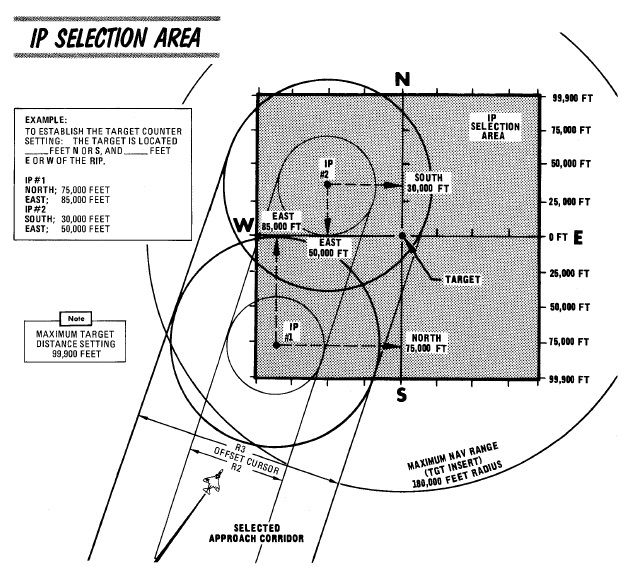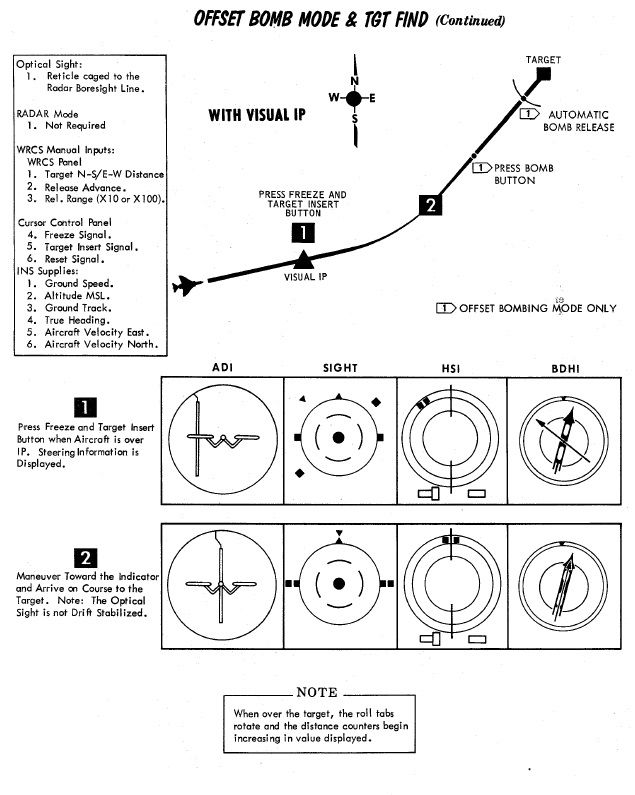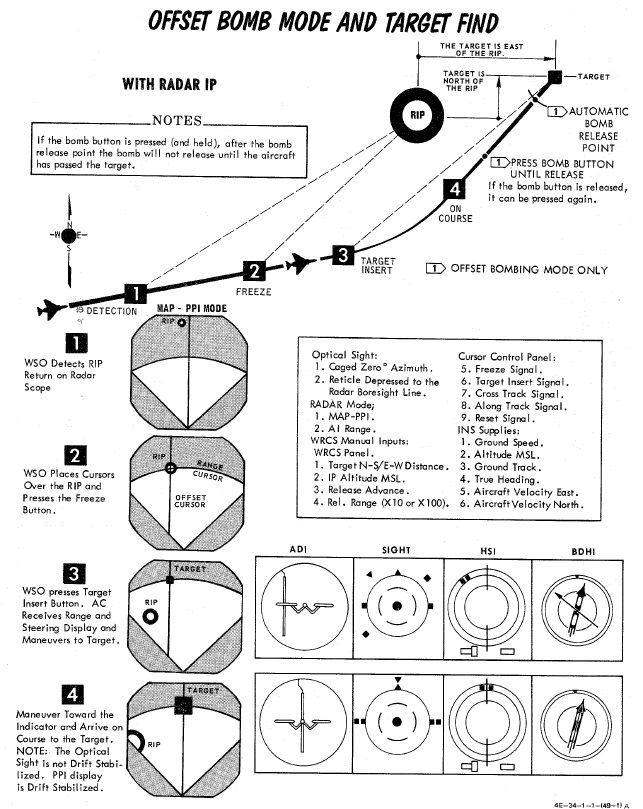Offset Delivery - OFFSET
Offset bombing provides a blind bombing capability, with high and low level bombing profiles, using the full integration of the WRCS, INS, and radar in combination. Offset bombing can be used in both visual and instrument conditions, to release either bombs or dispensed munitions (with the RKTS & DISP mode).
The crew chooses a known reference point (IP) and obtains target position by a means of an offset to that reference point. After setting up the aircraft with the corresponding values, the attack is then flown by designating the reference point instead of the actual target. The aircraft can then automatically release weapons based on the offset values.
Identification Point
The setup for an Offset bomb attack is based around the selection of an IP relative to a known target location. For a visual attack, it is called VIP - the Visual Identification Point, and initiation of the navigation assistance is performed with a direct flyover of the VIP.
In an instrument conditions attack, the IP is called the RIP - the Radar Identification Point, and acquisition of this point using a radar lock in MAP-PPI mode generates a navigation solution to the target.
When chosen during planning, the VIP or RIP's position relative to the target determines a pair of offset values (hence the name of the mode); one in the North/South axis, the other East/West. Both offsets are noted in feet, and the maximum amount of offset in each axis is 99,900', or 16.44 nautical miles.
Also found during mission planning is the altitude of the IP, and selection is made using the lookup tables for the respective weapon, altitude above target, and speed, taking note of the bomb range. When preparing the WRCS entries, the offsets are always referenced from the IP to the target. Selection of an IP should be as close as possible to the target to minimize system drift by way of smaller navigation time and distance, and approach to the IP should be flown with a focus on minimizing maneuvering required to put the target nose on after IP acquisition (RIP) or flyover (VIP).
💡 The Bombing Calculator Tool can be used to convert offset values from direct range and direction to the required N/S and E/W distances.

RIP Low Altitude Considerations
Of special note in the RIP mode is the need to compensate for altitude difference in the event the ingress to target will be flown below the altitude of the RIP itself. Because the computations performed by the WRCS and navigation system are mechanical, selecting a RIP target altitude above the course can cause interference damage. To alleviate this, perform the following:
- Note the approach altitude above MSL.
- Subtract the approach altitude MSL from the RIP altitude above MSL.
- Subtract the resulting value found in 2. from the approach altitude.
The resulting value is used for the target altitude value, and the pilot flies the planned approach attitude during the target freeze and insert operations as per normal.
Procedure
Visual IP
Prior to IP overflight, the N/S and E/W offsets, release range (x10 per the window, or using the x100 switch modifier on the WRCS initiate panel), and any desired release advance setting should be entered. Additionally, the desired release timing and count should be selected on the AWRU.
The Offset Visual IP attack commences on overflight of the VIP, with the aircraft at the desired release altitude and speed; as the aircraft overflies the VIP, the WSO presses the Freeze Signal button, followed by the Target Insert Signal button on the Cursor Control Panel; doing so initiates INS target tracking. Freeze memorizes the position under the radar cursor, which by default is the current aircraft position. Insert then applies the entered offset data onto the memorized position to designate the target coordinates. At this time, the vertical ADI, Sight, BDHI, and HSI navigation aids will all show offset from the calculated release point, as well as target range on the HSI and BDHI.
Completion of the attack is performed by the pilot through maneuvering the aircraft to align course to the release point, maintaining the planned release airspeed and altitude, and, prior to reaching the release point, pressing and holding the bomb release button. If the bomb release button is released prior to munitions release, but at a range greater than the programmed release range, the attack can be recovered by pressing and holding the bomb release button until release occurs. When this takes place, the pull-up light will illuminate to confirm drop initiation. Should the bomb release button not be pressed until after the release point is passed, the bombs will not release until the target is passed; ergo, the bomb button should be released to cancel the run prior to errant bomb drop.
Once an attack is completed, the navigation program against the set target is maintained. The aircraft can attempt a re-attack, although natural INS drift may reduce the accuracy of this second attack.

Radar IP
Prior to RIP Freeze and Target Insert, the N/S and E/W offsets, RIP altitude, release range (x10 per the window, or using the x100 switch modifier on the WRCS initiate panel), and any desired release advance setting should be entered. Additionally, the desired release timing and count should be selected on the AWRU. Prior to initiation, the pilot should enter the target area at the desired profile altitude and airspeed. The WSO should have the APQ-120 prepared for the attack with a good radar picture in MAP-PPI mode, NOR stab mode, WIDE scan, and a range of 10 or 25 miles, with an observed return from the RIP.
Initiation of the attack begins with placing the Along Track cursor (presented as a growing hemisphere on the radar display defining range to the RIP) in proximity to, but below, the intended RIP return. When this is set, the Cross Track cursor (a vertical line) is slewed over the RIP. Once the intersection is defined, the WSO waits momentarily until the RIP range decreases and falls onto the intersection. At this time, the WSO pushes the Freeze button. This initiates radar tracking of the RIP, and provides the opportunity for the WSO to better the intersection point between the Along Track and Cross Track cursors. Once the precise point is attained, the WSO pushes the Insert Target button, which hands target guidance off to the INS and performs an immediate slew of the Along Track and Cross Track cursors from the RIP to the offset target.
At this time, the INS presents guidance and range information on the ADI, the sight, the BDHI, and the HSI. The WSO should continue to monitor the radar display - should the actual target appear on the display as range decreases, the actual known altitude of the target can be entered on the WRCS panel and the Along Track and Cross Track cursors can be touched up using their controls to further increase release precision.
Prior to release range, the pilot must press and hold the bomb release button. Once the bombs have released, the pull-up light will illuminate to confirm release.
In the event that a RIP profile, due to breaking weather conditions, transition to a VIP-possible profile, the offsets can be kept in the WRCS, and the pilot simply fly over the RIP, with the WSO pressing the Freeze and Target Insert buttons simultaneously, just like a VIP attack.

Practice
If no Pave Spike targeting pod is installed, the TGT FIND mode can be used as a practice mode for OFFSET.
It then functions identical to the OFFSET mode with the difference of not sending an actual release signal to the weapons.